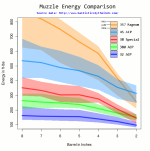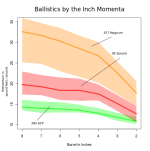UPDATED 2011-07-07: I added .357Mag and 45ACP to the graph
I'm looking for something for concealed carry, preferably small and light. I was looking at numbers for 38 Special and 380 ACP, and getting a little bewildered by it all. I thought that visualizing it instead of trying to flip back and forth between tables of numbers might help. Using the data from http://www.ballisticsbytheinch.com/, I put together the following graph. Note that I converted to muzzle energy, since that combines bullet weight and velocity (I am aware that some aren't fans of the energy metric, but I need some metric!):

One caveat, of course, is that BBTI uses the semi-auto method of barrel length measurement, so I'm not exactly sure where to put the real-life revolvers (I checked a couple loads against manufacturer test barrels, and it looks like adding 0.5" to 0.75" to the revolver's barrel finds about the right spot on the graph). But anyway.
I was surprised to see the convergence of the 38 Special and 380 ACP. I had believed that I should avoid the 380 as "below the minimum", but in the short barrel category, it seems to compare favorably (given careful load selection) with the .38, which seemingly receives much less criticism from the "pundits."
I guess if I'm willing to carry a 38 Special in a 2" barrel (which maps to ~2.75" on this graph, if my back-of-napkin estimations are correct), then I should be willing to carry a 3" 380 ACP, eh?
I'm looking for something for concealed carry, preferably small and light. I was looking at numbers for 38 Special and 380 ACP, and getting a little bewildered by it all. I thought that visualizing it instead of trying to flip back and forth between tables of numbers might help. Using the data from http://www.ballisticsbytheinch.com/, I put together the following graph. Note that I converted to muzzle energy, since that combines bullet weight and velocity (I am aware that some aren't fans of the energy metric, but I need some metric!):
One caveat, of course, is that BBTI uses the semi-auto method of barrel length measurement, so I'm not exactly sure where to put the real-life revolvers (I checked a couple loads against manufacturer test barrels, and it looks like adding 0.5" to 0.75" to the revolver's barrel finds about the right spot on the graph). But anyway.
I was surprised to see the convergence of the 38 Special and 380 ACP. I had believed that I should avoid the 380 as "below the minimum", but in the short barrel category, it seems to compare favorably (given careful load selection) with the .38, which seemingly receives much less criticism from the "pundits."
I guess if I'm willing to carry a 38 Special in a 2" barrel (which maps to ~2.75" on this graph, if my back-of-napkin estimations are correct), then I should be willing to carry a 3" 380 ACP, eh?
Attachments
Last edited:


